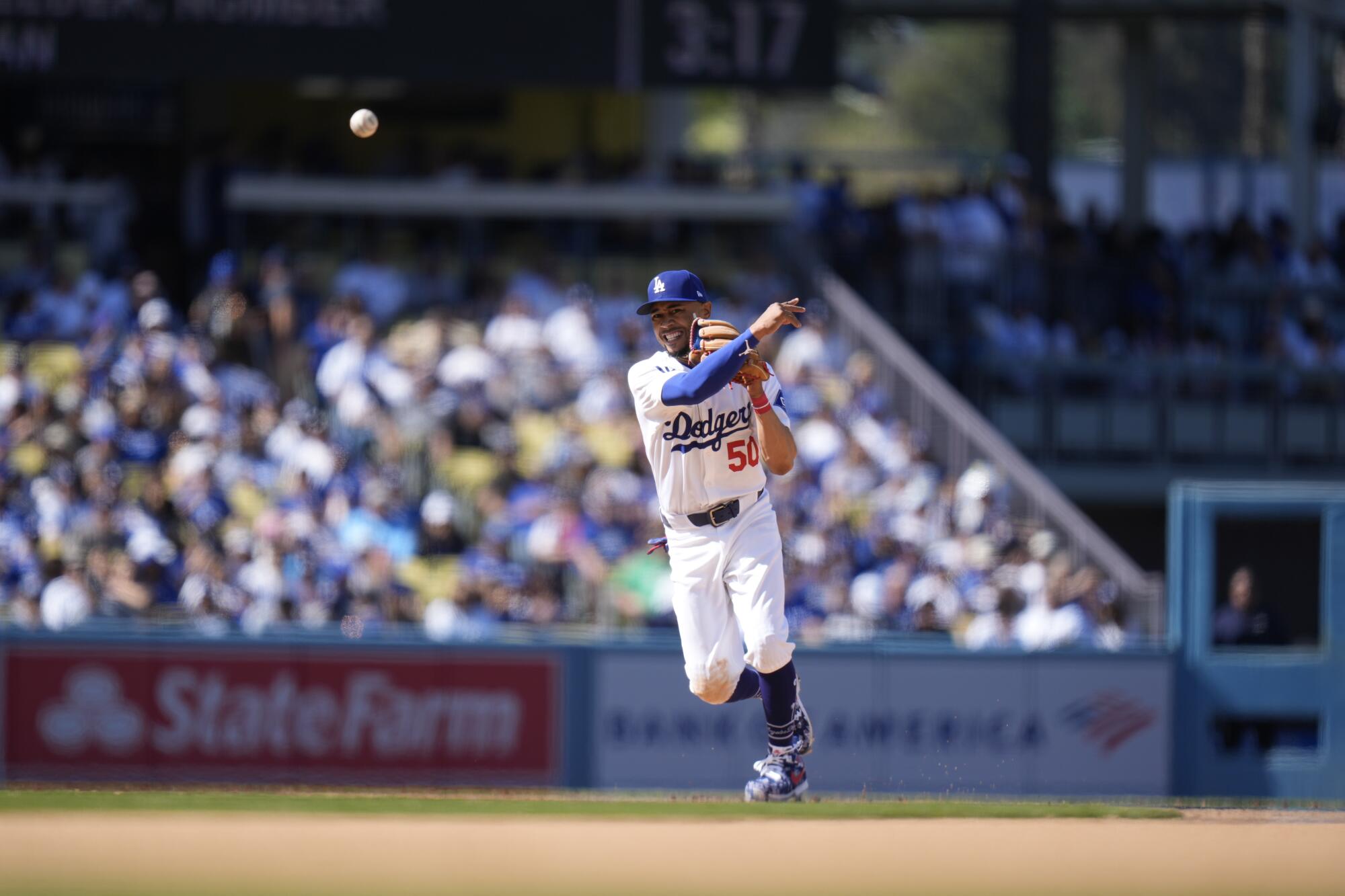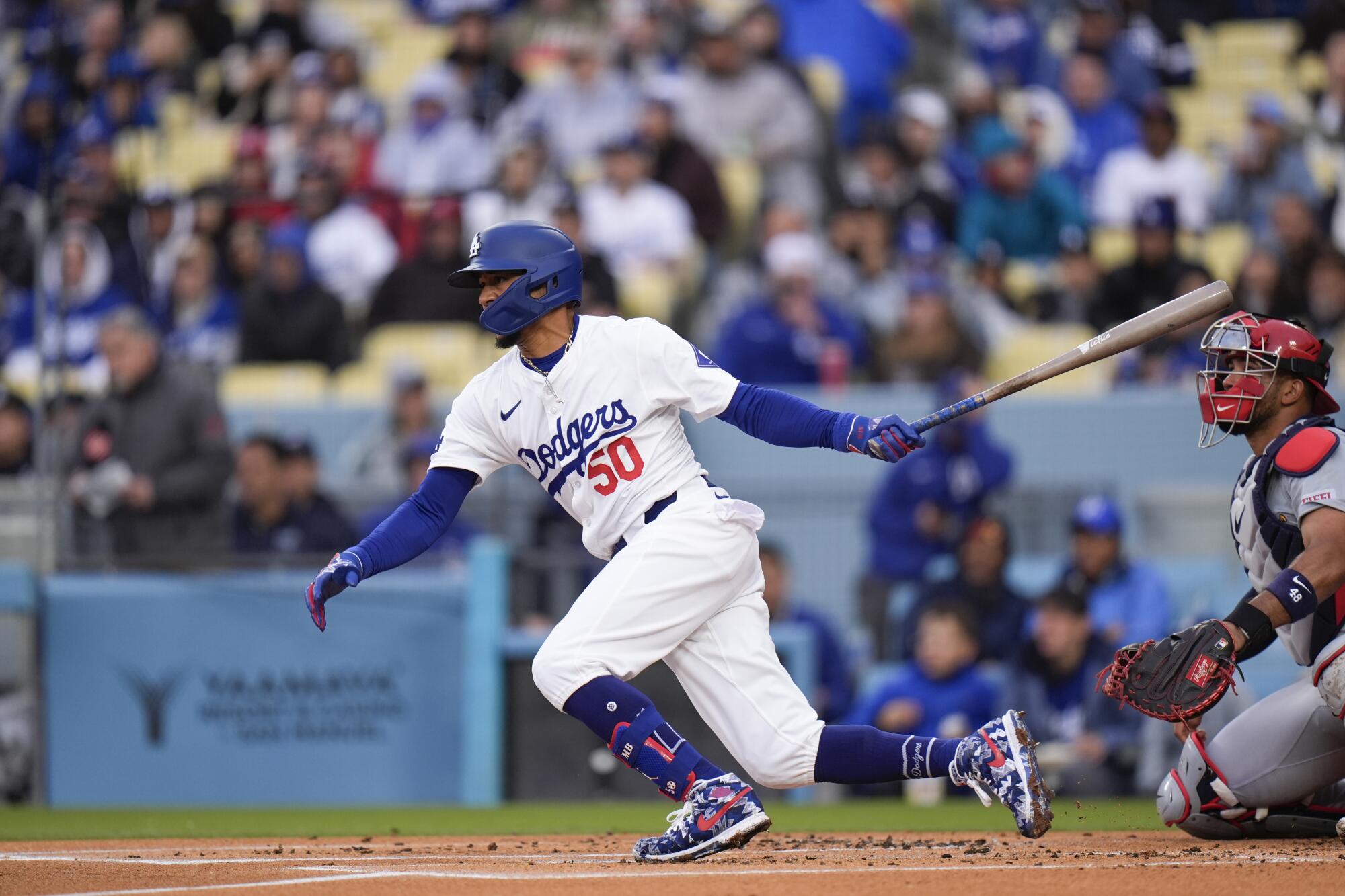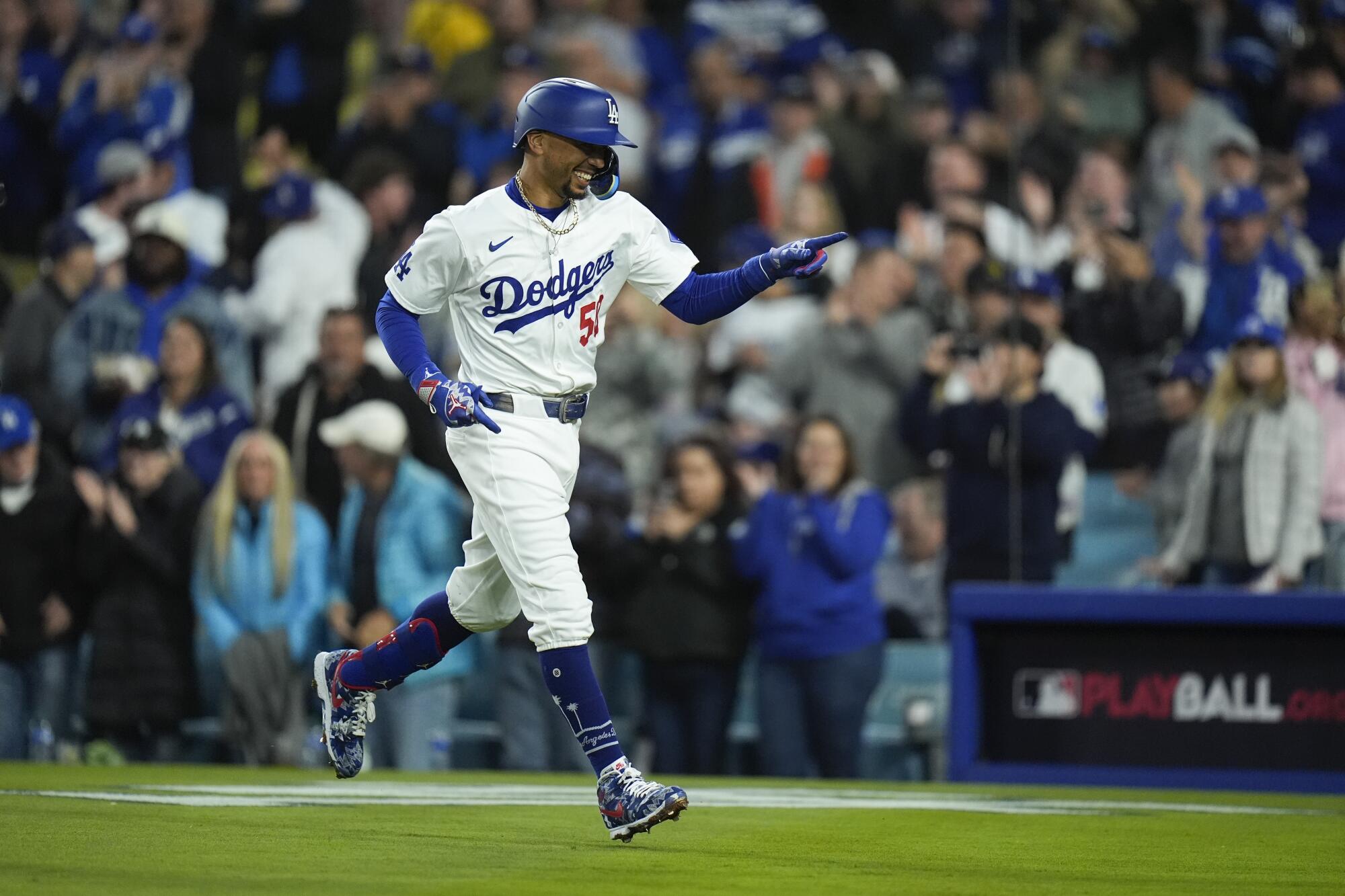[ad_1]
Mookie Betts has a reputation for seeking challenges.
Moving to shortstop shortly before the start of the regular season, however, was something the former MVP viewed through a different lens.
When the Dodgers started evaluating their shortstop options near the end of training camp — amid repeated defensive miscues from then-starting shortstop Gavin Lux — Betts didn’t outwardly ask to move to the position. He didn’t push the club for a radical infield change.
But, according to a person with knowledge of the situation who wasn’t authorized to speak publicly, Betts did let the team know that he was open to whatever decision they felt was best. He was prepared to move to shortstop, a position he hadn’t played regularly since high school, if needed.
Betts knew the level of difficulty it would entail. The possible pitfalls and failures he’d inevitably face.
Once the Dodgers opted to go that route, Betts embraced the move as not only the latest challenge of his 11-year career but a necessary obligation to best help the team.

Dodgers shortstop Mookie Betts makes a throw to first base during the eighth inning of a game against the Cardinals on Thursday.
(Jae C. Hong / Associated Press)
“It’s just a lot of responsibility out here,” Betts said this weekend.
One that the Dodgers’ most influential player is enjoying a little bit more every day.
Saturday offered the most encouraging example yet of Betts’ development at shortstop — which has coincided with his blistering four-homer, 10-RBI, 11-for-18 start at the plate.
For the better part of half an hour before the game Saturday, Betts practiced fielding one specific type of grounder he’d recently been struggling to handle, taking rep after rep on hard bouncers to his right.
Sometimes, Betts would flip his palm forward and try to scoop the ball on the opposite side of his body. On others, he went to his backhand and practiced a precise sequence of fluid motions: snatching the ball, setting his feet and firing a firm, accurate throw to first base.
More than a few times, Betts’ execution faltered.
Some of the grounders clanked off his brown, blue and red mitt. Others caught him indecisive on tricky in-between hops that skipped by him.
Successful rep or not, however, Betts would consult with infield coach Dino Ebel, or solicit instant feedback from teammate Miguel Rojas.
“The key thing is that he’s understanding what his strengths are, and the things he needs to work on,” Rojas said. “He’s doing this for the best of the team. To fix our problems, give flexibility to the organization and put our players in position to succeed.”
It was a microcosm of Betts’ new routine, the one he has adopted since the Dodgers heeded his receptiveness to a switch and officially moved to shortstop less than two weeks before opening day.
“I’m out there [messing] up all day. But when you get in the game, you just try to put it all together,” Betts said. “That’s what makes it fun. Making mistakes and learning from them.”
Later Saturday night, Betts experienced his most gratifying breakthrough yet.
Three times in Saturday’s loss to the St. Louis Cardinals, Betts had to range to his right to field a grounder — just like the ones he spent so long earlier in the afternoon trying to perfect.
All three times, Betts converted the play with ease: Backhanding a firm bouncer from Brandon Crawford in the third, rocketing a long throw to retire Nolan Arenado in the fourth, then limiting damage in the 10th by getting at least one out at first base on a slow roller with the infield in.
They were all plays a quality MLB shortstop would have been expected to make.
But, for a relative novice at a position like Betts, each marked a significant step in the right direction.
“I was actually really proud of myself today making those plays, give myself a nice pat on the back,” Betts said postgame, a rare example of self-satisfaction from a 31-year-old veteran defined by his often unemotional, perfectionist tendencies.

Dodgers shortstop Mookie Betts follows through with his swing after hitting a single during the first inning Saturday.
(Jae C. Hong / Associated Press)
“May go have a milkshake tonight because I did it,” he added with a laugh. “I’m very proud of myself for making those plays, and all the work [I’ve been putting in].”
Indeed, Betts’ approach to his shortstop transition has felt different than the other challenges he has tackled in his career — from on-the-field endeavors like last year’s Home Run Derby, to his off-the-field adventures in bowling, podcasting and philanthropy through his 50/50 Foundation.
When he moved from second base, where he was already preparing for a full-time switch this year, to shortstop, coaches and teammates noticed a renewed seriousness in the seven-time All-Star.
It wasn’t that his intensity changed, or even that he significantly increased his workload of defensive drills. Ebel insists Betts has been taking a similar number of daily grounders at short as he previously did at second, in part to ensure he doesn’t tire over a long season.
Yet, with a greater weight of responsibility resting on his shoulders, Betts attacked his new role with a can’t-fail attitude.
“He hasn’t taken a day off yet,” first baseman Freddie Freeman said, noting that on days the team has been off in recent weeks, Betts has been at the ballpark going through more rounds of infield drills.
“I think he’s just doing everything he can to make sure he is prepared for the position,” Freeman added. “I wouldn’t say the intensity has changed. It’s just more of, he’s trying to give himself — and us — the best chance. And that means obviously working extra.”
It helps that Betts has caught fire at the plate in the season’s opening weeks.
Entering Sunday, Betts had reached base safely in 18 of his first 25 plate appearances. He had six extra-base hits and only two strikeouts. He’d been on the kind of blistering tear that typically doesn’t materialize until later in the season.
“It’s so interesting, there’s just no exact science to it,” manager Dave Roberts said. “Early in camp, he was the most unlocked player, trying to find his swing. Freddie was the same way. Now you see them and they’re both swinging a hot bat. They’re just really good players and you just hope it syncs up sooner than later and those hot spurts last longer than they don’t.”
How much Betts’ heightened focus at shortstop has helped his form at the plate is another point of speculation.
While Betts himself wasn’t sure how much the two were correlated, Freeman wondered whether his teammates’ concentration on defense is “making him not worry so much about his mechanics” in the box. First base coach Clayton McCullough noted that, by the end of Betts’ daily pregame infield work, “the flip is switched and it stays on all day.”
There is still a long road ahead for Betts to cement himself as any sort of plus-fielder at shortstop, where he committed one error already this season during the Dodgers’ home opener Thursday.
One rival scout, after watching Betts commit a couple of miscues in a Freeway Series game last week, noted that he was still failing to make some plays even an average MLB shortstop would turn routinely.

Mookie Betts celebrates after hitting a home run during the first inning of the game against the Cardinals on Friday.
(Jae C. Hong / Associated Press)
Ebel and Roberts have acknowledged Betts’ room for growth, emphasizing that for all of the superstar’s natural athletic capabilities, it will take time for him to hone the fast-reaction instincts — like how to play grounders to his right, when his momentum is taking him away from first base — his new position requires.
“People need to understand, this is not easy to do,” said Rojas, who will regularly spell Betts at shortstop to give him occasional starts back at second base. “He’s figuring it out on the fly.”
That’s why, every day, Betts is on the field early, taking full-intensity grounders off a fungo training bat while a large clock times his ability to turn plays at game speed — 4.3 seconds is the standard time to beat.
He has approached his shortstop transition as not only a challenge for himself, but a necessary task that will be critical to the success of this year’s team.
“I told him, ‘There’s gonna be some mistakes here where you’re gonna be mad at yourself.’ That’s just part of it,” Ebel said from the dugout Saturday, glancing at the space between second and third base. “That [position] is gonna be OK for him soon. Sooner than most guys can get it, because he’s so gifted.”
[ad_2]
Source link

